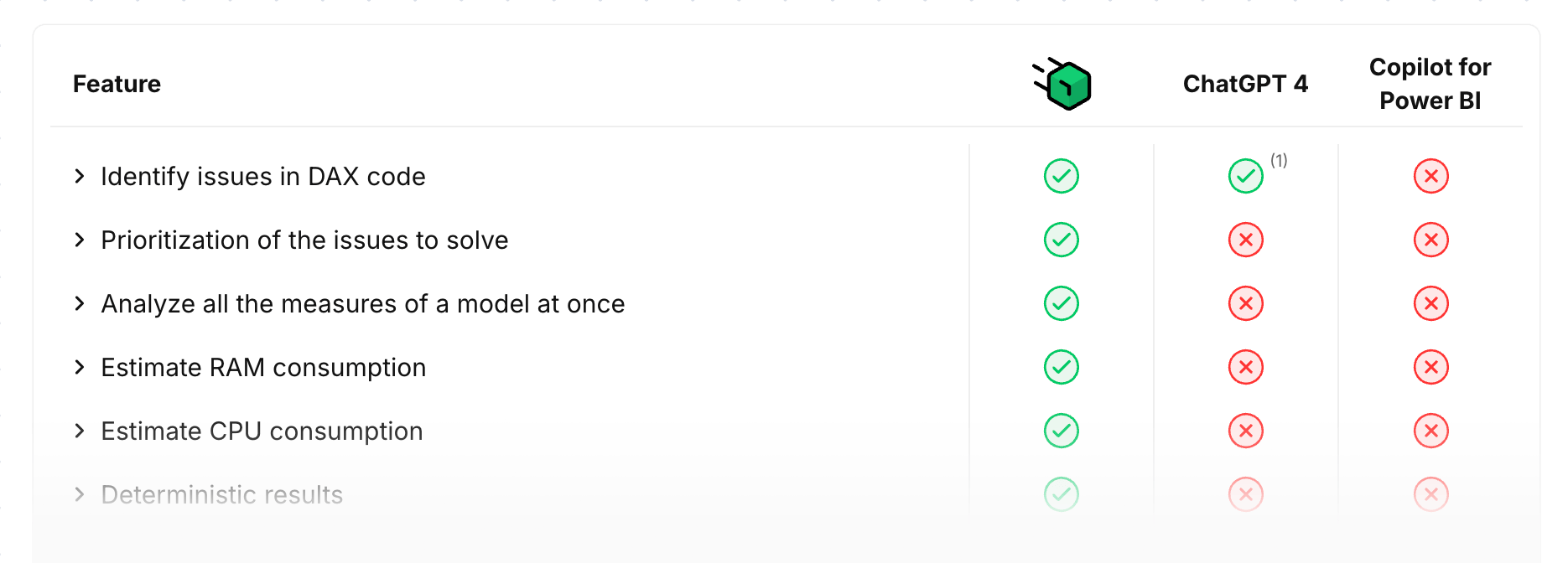This week, we launch our new campaign for DAX Optimizer: “Better than AI.”

This catchphrase is good for marketing, but it really explains the power of DAX Optimizer. This development effort required multiple years of work to offer an advanced and productive solution to optimize and improve the DAX code of your semantic models.
The role of AI in DAX development
Artificial Intelligence tools like ChatGPT and Copilot have made significant signs of progress in assisting developers with code generation and problem-solving. It’s impressive how AI can interpret natural language queries and provide code snippets that seem helpful at first glance. However, regarding the context-dependant nature of DAX, relying solely on AI can sometimes lead to suboptimal results.
With specific prompts, you can improve the quality of the results to analyze existing DAX measures, but each prompt is aimed at analyzing one measure at a time. Analyzing all the measures of a model at once is outside of reach for existing AI models. Moreover, only DAX Optimizer can estimate the cost of each measure and prioritize the effort, focusing on the more critical issues first.
A full comparison
At a very high level, these are the key differences between DAX Optimizer and AI tools:
- Specialization matters: DAX Optimizer is a tool specifically designed for the DAX language, while tools like ChatGPT and Copilot are general-purpose AI models. This specialization allows DAX Optimizer to understand the complexities and nuances of DAX far better than a generic AI.
- Contextual understanding: DAX Optimizer analyzes the entire semantic model, including statistics about tables and columns, to provide context-aware optimization suggestions. AI tools lack this deep integration and can only offer generic advice as they do not consider your specific data model.
- Quality of recommendations: The recommendations from DAX Optimizer are performance-driven. In contrast, AI models might generate code that looks correct but does not improve performance—or worse, degrades it.
- Educational value: DAX Optimizer also highlights issues in coding practices to avoid potential errors or ambiguities in the interpretation of the expression by another human, helping you become a better DAX developer. AI models often skip this educational component.
However, there is much more than that. We created a page with a detailed comparison between DAX Optimizer, ChatGPT, and Copilot for Power BI, with a 30-minute video describing each of the 16 key features of DAX Optimizer.

Time is your most precious resource: use it wisely and save it by using DAX Optimizer when it comes to optimizing your semantic model.
Meet us at the European Microsoft Fabric Community Conference
We’re excited to announce that DAX Optimizer will be featured at the Tabular Editor sponsor booth during the European Microsoft Fabric Community Conference in Stockholm on September 25-27, 2024. This event is a fantastic opportunity to see DAX Optimizer in action, meet our team, and learn how it can transform your DAX development process.
Whether you’re attending sessions, exploring new tools, or networking with other professionals, make sure to stop by our booth. We’d love to show you firsthand why DAX Optimizer is truly “Better than AI.”
Use a “Better than AI” tool
Our “Better than AI” campaign is more than just a slogan—it’s a commitment to providing the best possible tool to improve DAX expressions in semantic models. We believe that while AI has its place, specialized tools like DAX Optimizer offer unparalleled benefits when it comes to the complexities of DAX optimization.

